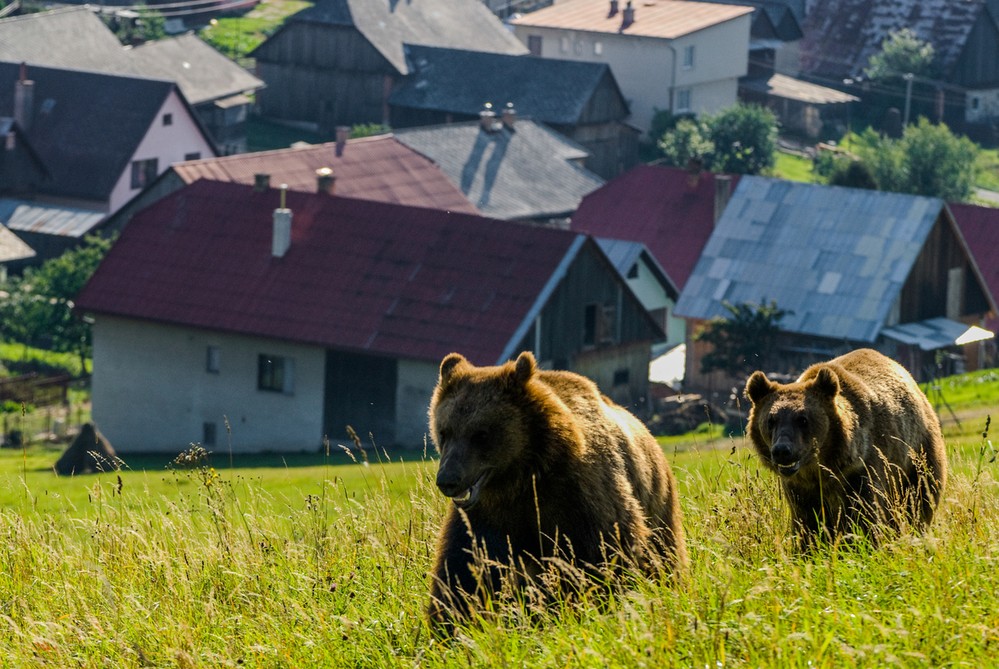ConnectGREEN - Creating green corridors to protect wildlife
10-08-2021
The Carpathian mountain range is one of the least fragmented areas in Europe. It provides home for the European Union's largest populations of large carnivores. But the habitats of these endangered species are threatened by the rapid modernization of the region. To balance the economic development with nature conservation, the ConnectGREEN project fosters transnational cooperation in restoring wildlife migration corridors.
June 18, 2021
 Bears near a village in Slovakia. Image: ConnectGREEN
Bears near a village in Slovakia. Image: ConnectGREEN
The Carpathians harbour natural treasures of great beauty and ecological value, and provide shelter for about one third of the carnivores in Europe. One of the major threats to its unique biodiversity is the fragmentation of the landscape, caused by the construction of transport infrastructure, industrial development, extension of recreation facilities as well as urban development.
Very few spatial planners in the region have the knowledge and experience to handle the growing conflict between development and nature conservation. More importantly, legally binding mechanisms taking into consideration the requirements of functioning ecological corridors are poorly implemented, mainly because of the lack of reliable data. As a result, new infrastructure projects split ecosystems into smaller isolated islands, limiting wildlife movement and gene flow between the populations of the species. The most affected are those species that require large natural habitats, especially large carnivores: grey wolf, Eurasian lynx and brown bear.
„The number of bears is growing in Slovakia, but we do not see them in the Czech republic. We think that this is precisely the consequence of the deteriorating permeability of the country.„
Michal Bojda, Hnutí DUHA
Providing safe passage for wildlife
In the ConnectGREEN project, partners joined forces to overcome the conflict between rural development and wildlife conservation by improving ecological connectivity. The aim is to ensure that animals have enough suitable space to overcome the barriers separating their natural habitats, especially between Natura 2000 sites and other protected areas of transnational relevance in the Carpathian ecoregion, namely in the Czech Republic, Hungary, Romania, Slovakia, Serbia and Ukraine. "Not only the protected areas in which large carnivores occur are important for their protection, but also the ‘connections’ – eco-corridors between them, which ensure irreplaceable gene movement," says Michal Bojda from Hnutí DUHA, which monitors large carnivores.
Ecological connectivity is not yet a part of spatial planning in most of the Carpathian countries, and therefore, is rarely considered when planning new economic projects. Based on a methodology developed by the ConnectGREEN project, intensive fieldwork was carried out since 2020 to identify and verify ecological corridors of and barriers to migration. In the Western Carpathians on the border between the Czech Republic and Slovakia, for example, four hundred barriers were identified and sorted into categories such as roads, railways, fences, built-up areas, non-forest areas, etc. The collected data was visualized on a map, showing core areas for large carnivores and ecological corridors of transnational relevance in the entire Carpathian ecoregion.
 Ecoduct in Slovakia. Image: ConnectGREEN
Ecoduct in Slovakia. Image: ConnectGREEN
New green corridors to be completed soon
The outputs of the project are already helping to put measures in place to maintain animal movement. In case of transport infrastructure, applying these solutions is very important not just for animals but also for humans, in order to increase traffic safety. For example, a new ecoduct Svrčinovec, is being built above the motorway in Slovakia, which, after completion in 2023, will connect the protected areas Kysuce (SK) and Beskydy (CZ). The monitoring conducted as part of the ConnectGREEN project confirmed that the location chosen for the ecoduct is also a functional migration corridor used by animals.
Csaba Balázs from the Cerová vrchovina Protected Landscape Area Administration (South-East Slovakia) where another construction of an expressway is underway says, that thanks in large part to the outputs of the ConnectGREEN project, the region now has the opportunity to plan for the protection of an entire system of migration corridors for animals in adequate density so that it can be truly functional "and animal populations on either side are not cut off from other populations."
Video: Mircea Vergheleț/National Park Piatra Craiului, Romania
